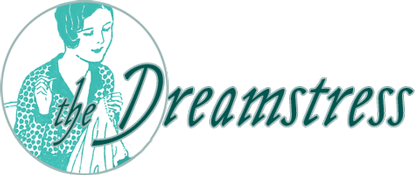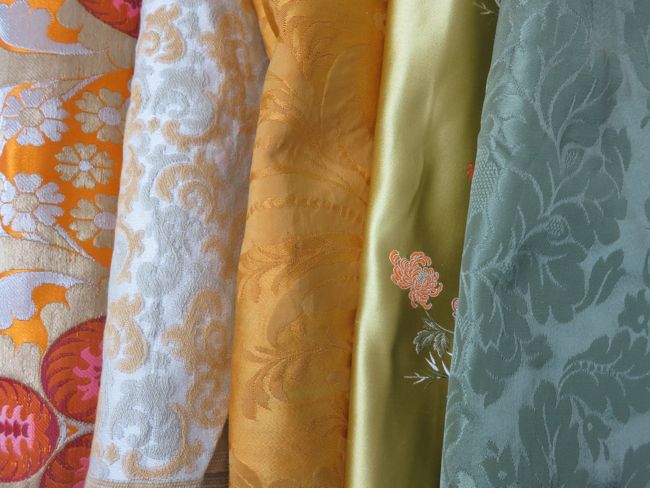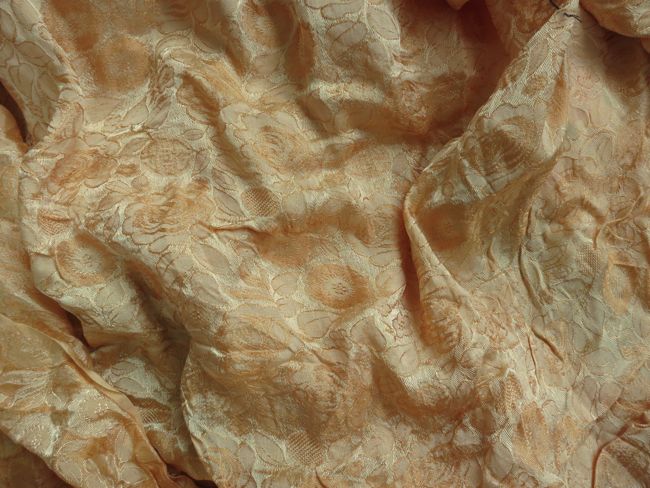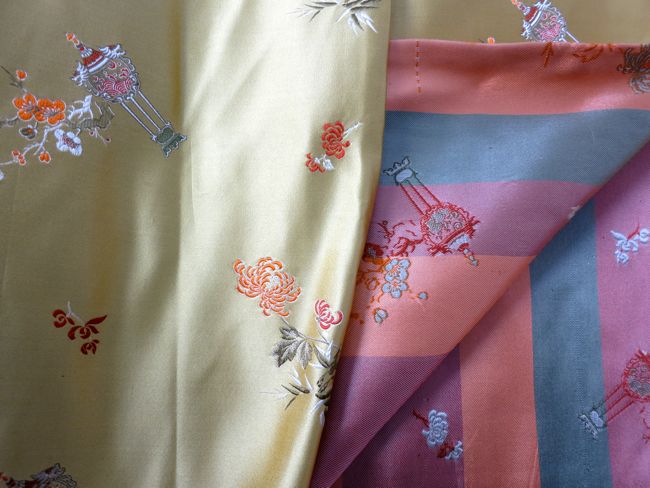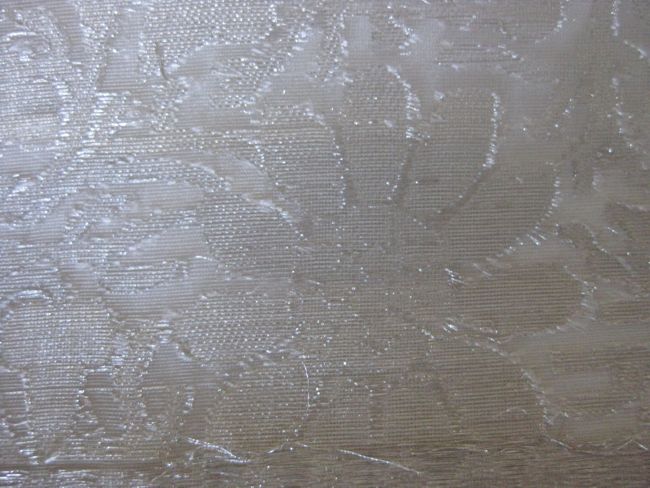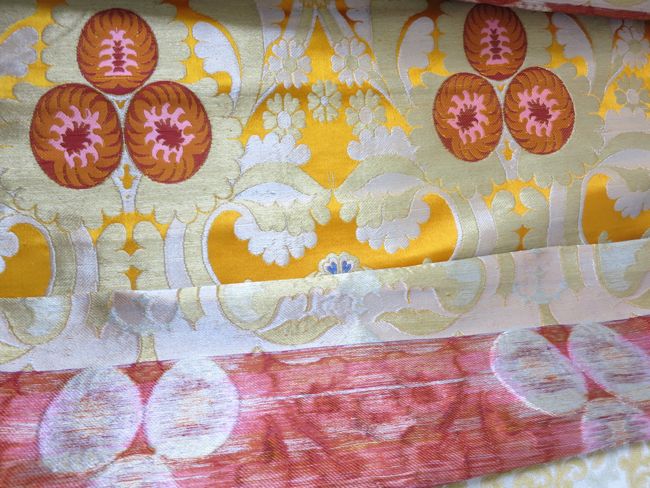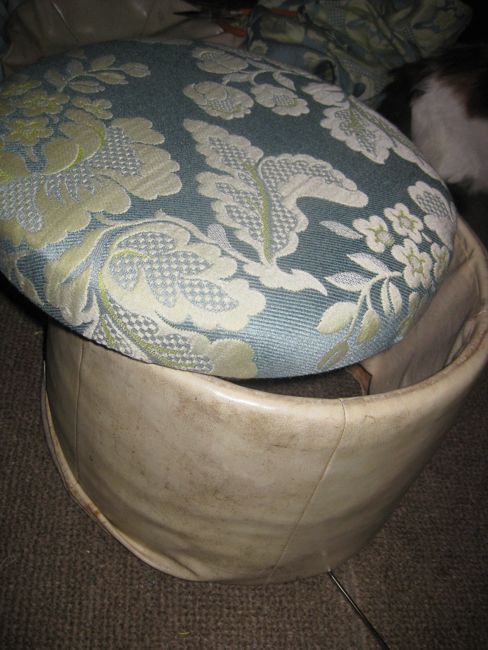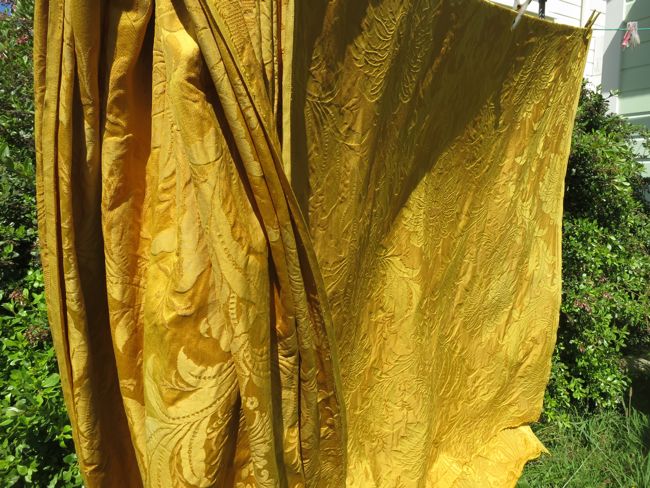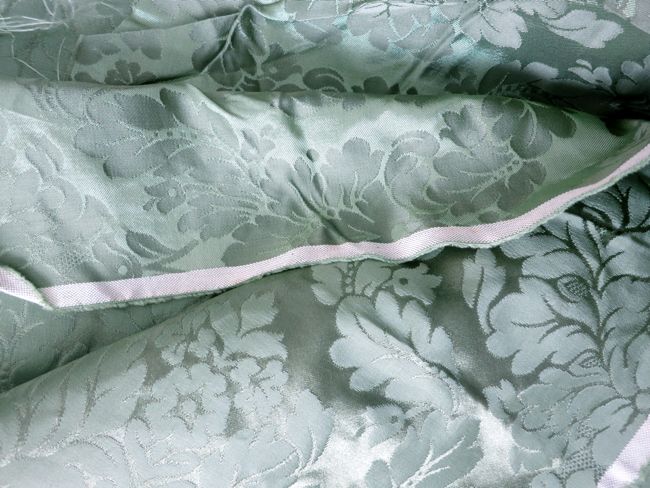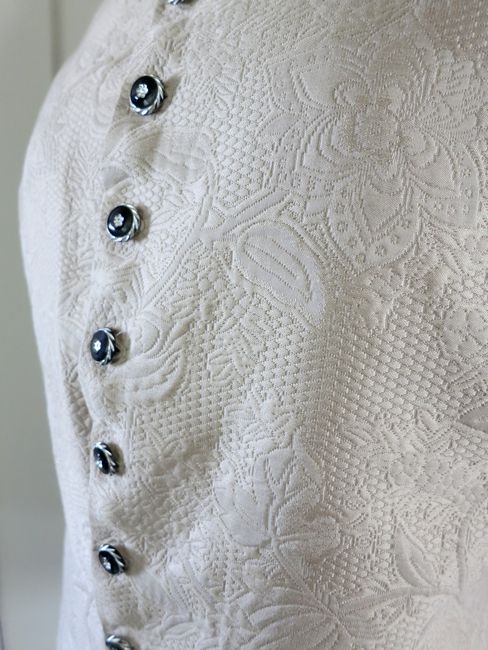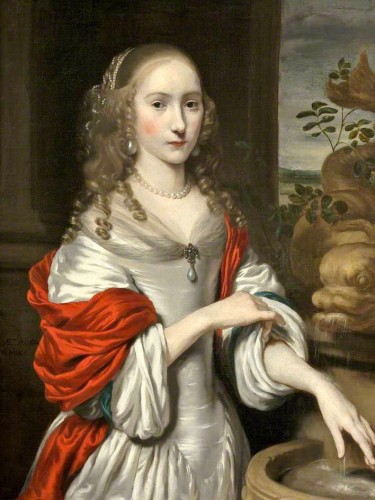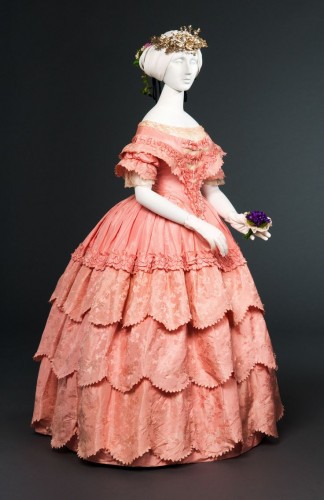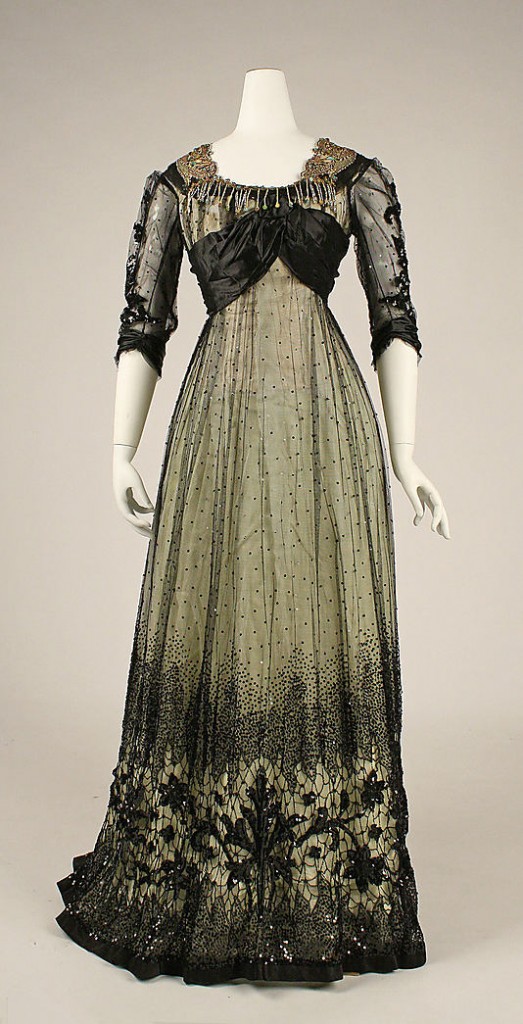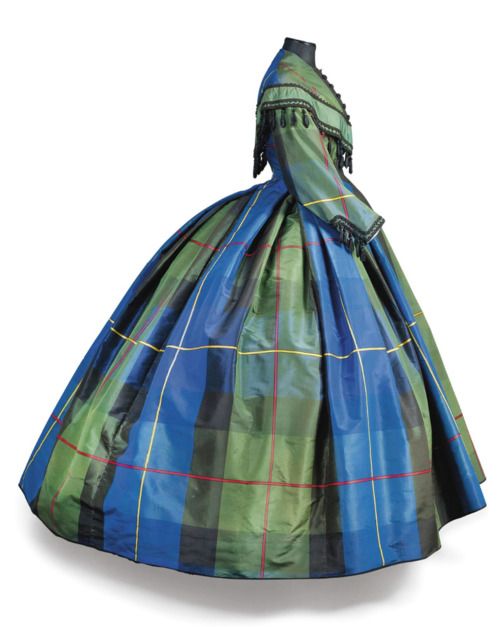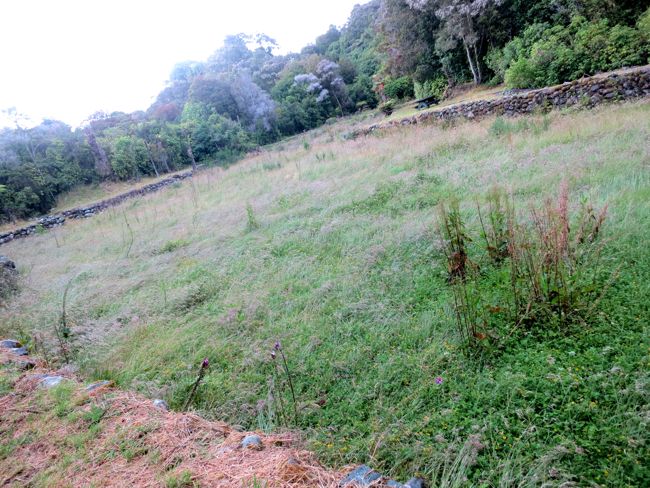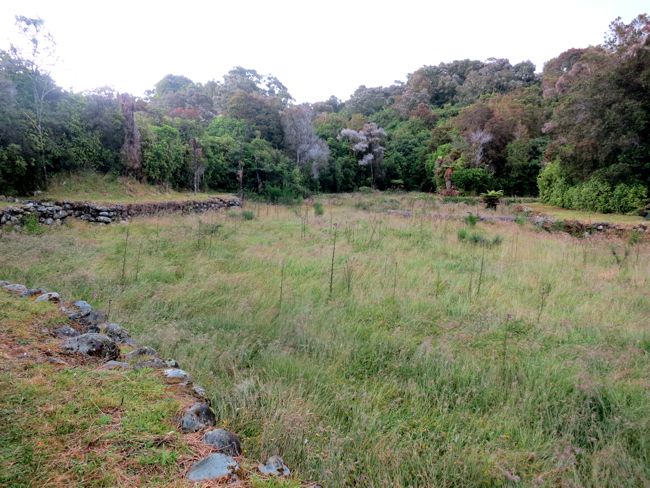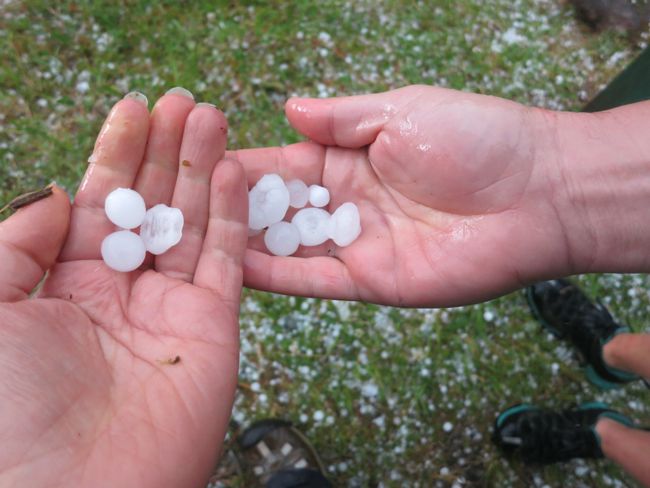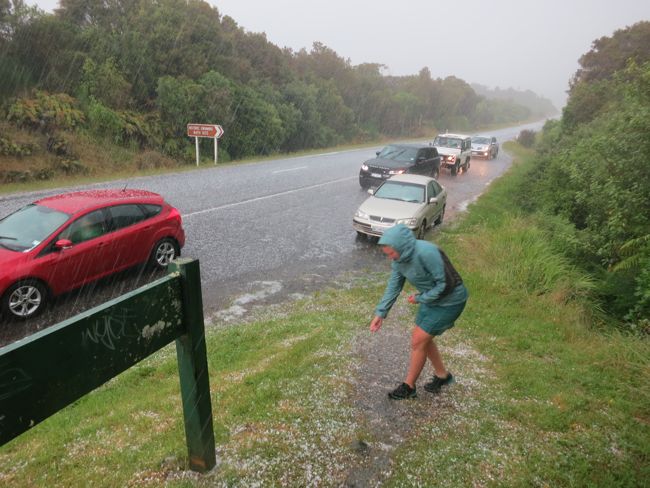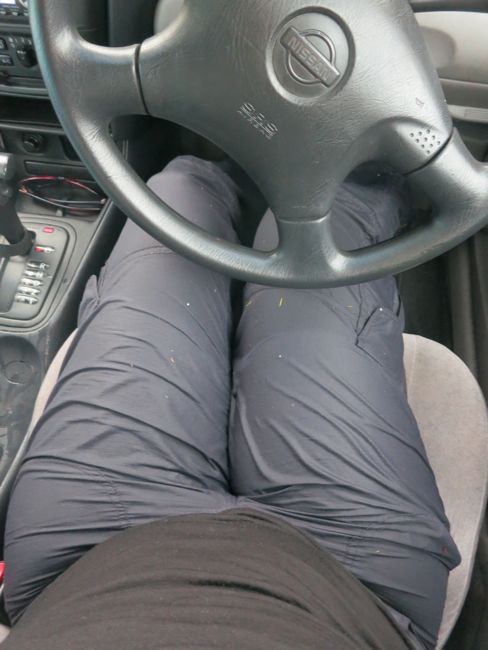A long time ago, when I posted the difference and between muslin, voile, lawn, and batiste (among other fabrics), someone asked if I could explain the difference between brocade and jacquard. I took a deep breath, and say “Yes, but it will take a while.” It certainly has, because it’s actually quite a big question, and there is so much confusion around it!
A lot of the confusion come from the fact that while the appearance of brocade has stayed very similar throughout history, the method of creating it has changed drastically. Prior to 1801 brocades were woven on hand operated draw-looms by master weavers, who manually created the elaborate brocade patterns as they were woven in with the help of a drawboy, who stood on a perch above the loom. Then, in 1801 Joseph Marie Jacquard demonstrated a new invention (albeit one based partly on a series of inventions from the 1740s-60s) – a loom which ran on cards with holes punched in them. Each card represented one line of a pattern, with the holes allowing threads to pass through into the pattern, changing the colours and creating a design.
The Jacquard loom revolutionised the production of elaborately patterned fabrics. Skilled craftsmen who could read pattern diagrams and manipulate the pattern as it was being woven were no longer needed to weave brocades and other designs, and the Jacquard loom did not require the assistance of an additional drawboy. The new looms could be operated by an unskilled labourer, making richly patterned fabrics faster and cheaper to produce. Jacquard looms were so much easier and cheaper to operate that the old style of looms quickly became obsolete, and within a few decades of Jacquard’s invention almost all elaborate fabrics woven in the West, including brocades, damasks, and richly patterned faux-Kashmiri or ‘Paisley’ shawls, were woven on Jacquard looms.
If the punch cards with holes which create a pattern sounds a little like an early computer – it is. The Jacquard loom and its punch card pattern system is considered an important point in the history of the computer. Babbage and Lovelace (the ‘Father of the Computer’ and world’s first computer programmer and first person to envision a computer that did much more than mathematical calculations (also Byron’s daughter), respectively) were familiar with Jacquards loom, and Babbage intended to use punch cards based on the loom punch cards in his Analytical Engine.
The jacquard loom was further revolutionised in 1843, with the invention of the dobby loom, which makes simpler patterned fabrics by a method of up to 40 frames which lift according to a programme. The dobby loom was even cheaper to run than the Jacquard, and supplanted it for all simpler patterned weaves. Dobby loom patterns, however, are limited to designs that stretch over 40 threads, whereas designs made on a Jacquard loom are virtually limitless. Today jacquard weaves are achieved not with a Jacquard loom, but rather a Jacquard head which is fitted on to a dobby loom.
Almost all modern brocades are woven with a jacquard device, so one could say that all modern brocades are jacquards, but not all jacquards are brocades, because jacquard looms are used to create other weaves, such as brocatelle, damask and tapestry.
Today the name jacquard usually applies to all weaves that can be achieved with the machine, but it is sometimes used to describe one specific type of fabric woven using a Jacquard loom: a light, soft, draping damask weave (see damask weaves below) of silk, rayon or synthetic fibres, which is why descriptions of jacquard as a fabric sometimes say daft things like ‘similar in appearance to damask’.
Here are some of the most common weaves achieved on a jacquard loom. Because a jacquard head can produce an almost infinite variety of weaves, there are many fabrics produced with a jacquard loom that don’t fit nicely into one weave category or another, so certain fabrics (particularly brocade & tapestry) can be quite fluid or imprecise in their definition:
Brocade: These days brocade frequently describes the aesthetic of a fabric, rather than a specific weave. Brocades are fabric with an elaborate embossed or embroidered surface effect, usually with different ground and pattern weaves. The name comes from the Italian brocatto, meaning ’embossed cloth’. Unlike damask, brocades are not reversible. Continuous brocades have the weft threads left loose and floating on the back. Some continuous brocades have the back threads cut away, though the short cut ends are still visible. A discontinuous brocade is one where additional yarns are only woven into the patterned areas, resulting in a smoother back.

A continuous brocade with a pattern formed of lame threads that have been cut on the reverse of the fabric.
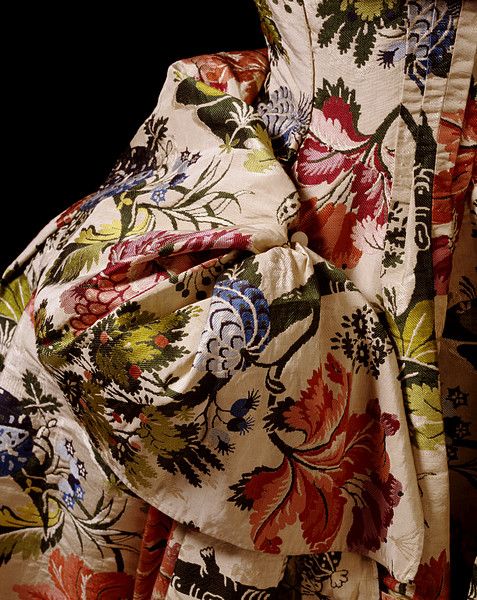
Mantua, England, 1733-1734 (woven) 1735-1740 (made), Brocaded silk, hand-sewn with spun silk and spun threads, lined with linen, brown paper lining for cuffs, brass, canvas and pleated silk detail, Victoria & Albert Museum
Brocading: brocade or other jacquard weaves with the inclusion of gold or silver coloured threads. It is also called Imperial Brocade.
Brocade velvet: a patterned velvet with a raised pile and a woven ground (not to be confused with a burnout velvet, where the patterning is achieved by burning out the pile with acid, rather than weaving in the pattern from the start).
Brocatelle: Similar to brocade, but the patterned areas are more distinct and raised, and the fabric is heavier.
Damask: Patterned fabrics with a ground of one weave (usually plain, twill or sateen) and designs in other weaves (particularly satin and twill variants), so that the patterned areas have sheen and reflect light, Damasks are always reversible, with the pattern weaves becoming the ground weaves on the reverse (so on a fabric with a plain ground and satin pattern front, the ground would be satin and the pattern plain on the reverse). There are tone-on-tone damasks, with different weaves within the damask creating elaborate floral or geometric patterns, and multicoloured damasks, where the background colours and the pattern colours reverse from front to back. My Polly Oliver jacket is made from a red tone-on-tone jacquard damask.

Tea gown with 18th century inspired back pleats, ca. 1905, Callot Soeurs, silk damask, lace, Victoria & Albert Museum
Matelasse/Marcella/Pique: a weave specifically designed to imitate quilting with a characteristic bubbled/blistered raised effect.
Tapestry: In modern terminology ‘tapestry’ just means a fabric woven on a jacquard loom that imitates historical tapestries. It’s a very imprecise term, but it describes a heavy fabric with an elaborate, multicolour weave, usually with the colours reversing on the back of the fabric (for example, a fabric with green leaves on a red ground would have red leaves on a green ground on the reverse), but is thicker, stiffer, and heavier than damask, the reverse may not be as neat and tidy, and is usually woven with thicker yarns than damask or brocade.
If you are looking at a modern jacquard weave fabric and trying to determine what it is most likely to be called, ask yourself:
– Is it reversible, with the pattern a mirror of each other on each side? If so – it’s a damask. If it’s light and drapey, some people might call it a jacquard.
– Is one side beautiful, and the other side a mess of floating threads? It’s a continuous brocade, unless it’s very heavy, and the pattern is very raised, and then it is a brocatelle.
– Is one side beautiful, and the other a mess of short, cut threads? Its a discontinuous brocade, unless it’s very heavy, and the pattern is very raised, and then it is a brocatelle.
– Is one side beautiful, and the other a pattern of coloured stripes? It’s a type of brocade.
– Is it a brocade with gold and/or silver coloured threads? It’s an imperial brocade/brocade with brocading.
– Is it quite textured, with puffy, blistered areas on the front and a loose, gauzy support weave on the back? It’s a matelasse/marcelle/pique
– Is it really elaborately patterned, quite heavy, and doesn’t fit any of the other descriptions? It’s a tapestry weave.
Jacquard looms can also be used to create elaborately patterned knits, including:
Jacquard hose: socks and stockings with elaborate patterns, such as argyle, herringbone, and other socks with the patterns woven in. Stockings/socks/hose have been knit on jacquard looms since the 1920s, and have gone in and out of popularity since then.
Jacquard sweaters: machine made sweaters with elaborate patterns knitted in. Most ugly Christmas sweaters? Yep. Those are jacquard sweaters. Aztec sweaters – those are jacquard sweaters. Machine knit argyle sweaters are knit on a jacquard loom. Faux Fair Isle and Cowichan sweaters are knit on jacquard looms.
And if you are interested, weaves that are usually done with a dobby loom are birds eye (diaper cloth), crepes, cloche, dotted swiss, double-weaves, honeycomb weaves, simple matelasse/pique patterns, satins, and elaborate twills, as well as fabrics with small, simple widely spaced designs.
Sources:
Cant, Jennifer and Fritz, Anne, Consumer Textiles. Melbourne: Oxford University Press. 1988
Calasibetta, C. M., Tortora, P, and Abling, B (illus.). The Fairchild Dictionary of Fashion (Third Ed). London: Laurence King Publishing Ltd. 2003
Collier, Billie J. and Tortora, Phyllis G. Understanding Textiles (Sixth ed). Upper Saddle River, New Jersey: Prentice Hall Inc. 2001
Shaeffer, Claire. Claire Shaeffer’s Fabric Sewing Guide. Iola, Wisconsin: Krause Publications. 2008
Wilard, Dana. The Fabric Selector. Millers Point, NSW Australia: Murdoch Books Pty Ltd. 2012
